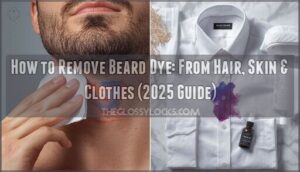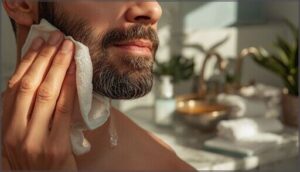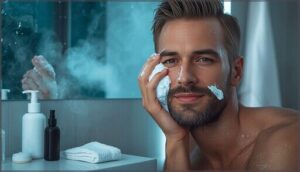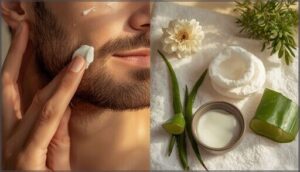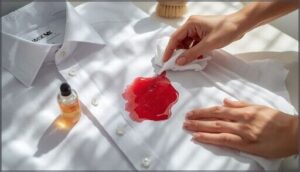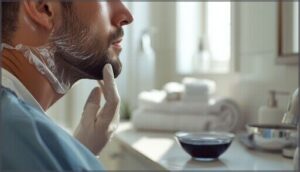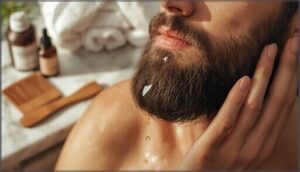This site is supported by our readers. We may earn a commission, at no cost to you, if you purchase through links.
If you’ve ever glanced in the mirror and spotted a streak of dye running along your jawline—or worse, a patch of color clinging to your favorite shirt—you know beard dye doesn’t always stay where it’s supposed to. The difference between a sharp, fresh beard and a blotchy mess often comes down to how quickly you act.
Whether you’re dealing with a temporary tint or a stubborn permanent stain, knowing how to remove beard dye can save your skin, your clothes, and your confidence. With the right know-how, you’ll keep your look crisp and your cleanup stress-free.
Table Of Contents
- Key Takeaways
- Assessing Your Beard Dye Type
- Immediate Steps After Dye Application
- Removing Temporary Beard Dye
- Removing Semi-Permanent and Permanent Dye
- Removing Beard Dye From Skin
- Eliminating Beard Dye Stains From Clothing
- Preventing Future Beard Dye Staining
- Caring for Skin and Beard After Dye Removal
- Frequently Asked Questions (FAQs)
- Conclusion
Key Takeaways
- Acting fast—within minutes—after applying beard dye is crucial for easy removal and preventing stains on skin and clothes.
- Temporary dyes wash out with mild soap and water, while semi-permanent and permanent dyes often require baking soda, dish soap, or commercial removers.
- Protect your skin and clothes by applying barrier creams, wearing gloves, and prepping your workspace before dyeing.
- Moisturize and monitor your skin for irritation after dye removal, and wait at least two weeks before re-dyeing to keep your beard healthy.
Assessing Your Beard Dye Type
Before you start removing beard dye, you need to know what you’re dealing with. Different dye types require different removal approaches, and what works for one won’t necessarily work for another.
Let’s break down how to identify your dye type and assess the situation you’re facing.
Identifying Temporary, Semi-permanent, and Permanent Dyes
How can you tell which type of dye you’re working with? Check the packaging first—temporary beard dyes often say “washes out” or “removes in one wash,” while semi-permanent options note “4–6 weeks” or “24–36 washes.” Permanent hair color labels mention ammonia or long-lasting results.
The regrowth appearance also differs: permanent dyes create sharper lines, while semi-permanent options fade gradually. High-quality dyes can offer improved color durability.
Understanding Dye Ingredients and Skin Sensitivity
Beyond just the dye type, you’ll need to know what’s inside the bottle. Most permanent beard dyes contain p-phenylenediamine (PPD)—found in over 90% of formulas—which triggers allergic reactions in roughly 6% of North American users. That’s why patch tests matter. The dyes often contain harsh chemicals like ammonia and peroxide.
Pay attention to these risk factors before applying dye:
- Existing skin conditions: Prior eczema or dermatitis increases your sensitivity risk substantially
- Repeated exposure: Each application raises PPD sensitization odds, especially for frequent users
- Incomplete labeling: Products without clear ingredient lists often exceed safe PPD concentrations
Determining How Long The Dye Has Been On
Knowing the dye duration makes all the difference. Temporary dyes set in 30 seconds, semi-permanent needs 5–10 minutes, and permanent locks in after 15 minutes. If you’ve exceeded those windows, removal difficulty skyrockets—semi-permanent dye becomes 60% harder to lift after just 10 extra minutes. Check your application records or estimate based on visual cues like color depth.
| Dye Type | Setting Time | Removal Difficulty After |
|---|---|---|
| Temporary | 30 seconds | Minimal (water works) |
| Semi-permanent | 5–10 minutes | Moderate (needs abrasives) |
| Permanent | 15+ minutes | High (requires strippers) |
The longer dye sits, the deeper it penetrates—especially on recently shaved skin where absorption rates jump 45%. That’s why 89% of stubborn beard dye stains happen when you’ve exceeded manufacturer timing. For removing dye stains from skin, acting fast is your best weapon against permanent marks.
Immediate Steps After Dye Application
The first few minutes after applying beard dye can make or break your removal efforts. If you catch fresh dye before it sets, you’ll save yourself hours of scrubbing later.
Here’s what you need to do right away to stop staining in its tracks.
Using Soap and Water for Fresh Dye
Catching dye stains within the first five minutes is your best shot at removing up to 70% of the pigment. Immediate application of gentle soap and warm water makes all the difference for fresh beard dye removal.
- Wet the stained area with warm water to open pores
- Lather mild soap using circular motions with your fingertips
- Scrub gently for 30-60 seconds without abrading skin
- Rinse thoroughly and repeat up to three times if needed
Timing and Effectiveness of Rapid Removal
When you’re working against the clock, the removal window matters more than most guys realize. Temporary dyes practically vanish—95% gone with soap and water within five minutes.
Semi-permanent dyes? You’ve got 7-10 minutes before they set, dropping your success rate from 80% down to 40%.
Permanent dyes are stubborn beasts; waiting past 15 minutes kills your chances at removing dye stains from skin effectively.
Preventing Deeper Staining With Quick Action
Once dye hits your skin, you’re in a race against chemistry. Dye molecules start bonding with your skin proteins within 20–30 minutes, making removal exponentially harder the longer you wait. Immediate blotting with a clean cloth prevents deeper staining by interrupting absorption rates early.
Act fast—dye bonds to skin within 20–30 minutes, so immediate blotting is your best defense against stubborn stains
Here’s what stops stains cold:
- Blot within the first 10 minutes to reduce visible marks by 85–92%
- Rinse with soap and warm water within 5 minutes for 97% removal
- Skip waiting—early intervention prevents most long-term discoloration
- Have cleaning materials ready before you dye to get the most out of your response time
Your behavioral factors matter. Guys who prep their setup see zero lasting stains 67% more often than those who wing it.
Removing Temporary Beard Dye
Temporary beard dye is forgiving—it’s designed to fade fast, which means you’ve got real options to get it out. The good news is that gentle methods work best here, so you won’t need harsh chemicals or aggressive scrubbing.
Let’s walk through the cleanest ways to remove it without irritating your skin.
Gentle Cleansing Methods
Your skin’s barrier is delicate—treat it that way. Start with mild soap and lukewarm water, gently working the lather across your beard. For sensitive skin, micellar water offers effective cleansing without harsh chemicals. Oil cleansing works too: massage a light oil into a damp beard, then rinse. These gentle methods minimize irritation while gradually lifting temporary dye. Moisturize afterward to combat the 59% dryness many experience post-removal.
| Method | Best For | Time | Irritation Risk | Effectiveness |
|---|---|---|---|---|
| Mild Soap | All skin types | 5 min | Low | Moderate |
| Micellar Water | Sensitive skin | 3 min | Very low | Good |
| Oil Cleansing | Dry skin | 10 min | Low | Good |
| Gentle Exfoliation | Stubborn dye | 8 min | Moderate | Very good |
| Warm Water Rinse | Maintenance | 2 min | Very low | Light |
Using Beard Shampoo and Warm Water
The shower is your first line of defense for temporary beard dye removal. Warm water opens the hair cuticles, letting surfactants like sodium lauryl sulfate work into the shaft and lift those color molecules right out. You’ll see about 10-15% fading per wash—not magic, but solid progress.
- Work the lather in circular motions for better mechanical removal
- Temperature matters: aim for 37-40°C, not scalding hot
- Fresh dye responds faster than set-in color
- Two or three washes beat one long scrub session
Tips for Minimizing Skin Irritation
Treat your face like it’s recovering from a light scrape—gentle is the name of the game. After rinsing with lukewarm water, pat dry and skip the rough towel rubbing that’ll aggravate already-sensitive skin.
Sensitive skin needs extra attention—if you see redness or itching, ease off immediately. Moisturizing twice daily prevents the tightness and flaking that often follows removal attempts.
| Step | What to Use | Why It Works |
|---|---|---|
| Pre-Dye | Barrier cream or petroleum jelly | Blocks dye from reaching skin in the first place |
| During Removal | Gentle exfoliation with mild scrub | Lifts residual color without abrading the epidermis |
| Post-Removal | Fragrance-free moisturizers | Restores the skin barrier, reduces redness |
| If Irritated | Cool compress application | Calms inflammation and soothes discomfort |
| Daily Care | Beard oils or balms | Keeps both hair and skin hydrated long-term |
Removing Semi-Permanent and Permanent Dye
Semi-permanent and permanent dyes don’t wash out as easily as temporary color. You’ll need more aggressive methods to break down the pigment and lift it from your beard hair.
Here are three proven techniques that work when standard shampooing won’t cut it.
Baking Soda and Dish Soap Method
You’ll find one of the most reliable beard dye removal methods right in your kitchen. The mixing ratios matter—combine equal parts baking soda and dish soap (about 1 tablespoon each) into a thick paste.
Here’s how to improve removal efficacy:
- Massage the paste gently onto dyed areas for 2-3 minutes
- Leave it on for 5-10 minutes for stubborn dye stains
- Rinse thoroughly and assess if repeat applications are needed
This method can fade semi-permanent dyes by 50-60% in one go. Just watch for skin sensitivity—limit application time and don’t exceed three consecutive attempts to prevent dryness or irritation.
Commercial Dye Removers (e.g., Redbook Color Changer)
When baking soda doesn’t cut it, professional hair dye removal products like Redbook Color Changer deliver stronger results. These gel-based removers work without bleach or ammonia, reversing dye molecules to lighten permanent color by up to 80% in one or two sessions.
Most users see satisfactory beard dye removal after two applications, with over 75% reporting success—far better than household methods alone.
Multiple Application Techniques for Stubborn Dye
Even with commercial removers, permanent dye demands persistence. Sequential cleansing with soap and warm water—repeated two to three times in an hour—can lift over 70% of visible dye.
Layer exfoliation methods: follow a store-bought scrub with a homemade sugar-olive oil mix for up to 90% stain removal.
Reapply baking soda paste, lemon juice scrubs, or non-gel toothpaste in controlled cycles, moisturizing between sessions to prevent dryness.
Removing Beard Dye From Skin
Dye doesn’t just stain your beard—it gets on your skin too, especially around the jawline and neck.
The good news is you can remove those stains without scrubbing your face raw or reaching for anything toxic.
Here’s how to clean up dye on skin safely and effectively.
Safe Use of Rubbing Alcohol and Non-gel Toothpaste
When soap fails to remove beard dye from your skin, rubbing alcohol and non-gel toothpaste step in—but only when used correctly. These methods remove up to 80% of visible pigment, though they demand caution.
- Alcohol patch test first: Dab a cotton ball on your inner wrist to check for reactions before touching your face
- Toothpaste ingredients check: Avoid gels and verify you’re not sensitive to preservatives
- Application best practices: Use pea-sized amounts, never near eyes or broken skin
Post-removal skincare with moisturizer cuts dryness by 60%.
Exfoliating With Mild Abrasives
If rubbing alcohol or toothpaste leaves color behind, reach for an exfoliating scrub. A DIY mix—baking soda and mild soap—works well, especially when you massage gently in circles.
For sensitive skin, pick finer abrasive particle size and limit exfoliation frequency. Post-exfoliation care matters; rinse thoroughly and moisturize.
Sugar scrubs or store-bought options offer good skin care without harshness.
Avoiding Harsh Chemicals and Preventing Irritation
When you’re tackling beard dye stains on sensitive skin, skip harsh chemicals. Gentle alternatives like natural remedies and barrier creams protect skin health and minimize irritation.
Always do patch testing before trying something new. For immediate removal, act fast—don’t let dye sit. If redness or burning appears, consult a dermatologist. Your skin will thank you for this careful approach.
Eliminating Beard Dye Stains From Clothing
Beard dye stains on clothes can be stubborn, but quick action makes a big difference. If you’ve found a spot, there are a few proven ways to tackle it.
Here’s what you should know before you start cleaning.
Treating Stains Immediately
Ever notice how a beard dye stain seems to set faster than you can blink? That’s why immediate blotting is your best defense. Quick action stops dye stains from bonding deep into fabric fibers or skin. For best treatment, reach for safe removers and treat the spot within minutes. Remember, different dye types respond differently—cotton lifts stains 25% better than synthetics.
Here’s your rapid-response checklist:
- Blot with absorbent paper towels
- Avoid rubbing to prevent spreading
- Use cool water for fiber response
- Apply skin-safe stain removers
Washing Instructions for Effective Stain Removal
When you’re aiming for expert advice for stain removal, start by choosing cool water—hot water above 40°C can lock dye stains in for good. Select an enzyme-based detergent for cotton, or oxygen bleach for tougher stains.
Soaking methods matter: a 30-minute vinegar-water soak loosens dye stains, especially on lighter fabrics. For stubborn spots, repeat washing before drying.
Remember, fabric type affects results—polyester releases dye better than wool. Quick, careful action and the right detergent choice make all the difference in removing dye stains from clothing.
Preventing Future Beard Dye Staining
Keeping beard dye where it belongs can save you a lot of cleanup later. A few simple habits make all the difference.
Here’s how you can keep stains off your skin, hands, and clothes next time.
Barrier Creams and Petroleum Jelly Application
Think of barrier creams and petroleum jelly as your shield against dye stains. You’ll want to focus on:
- Applying petroleum jelly along the beardline and key application zones for maximum protection.
- Choosing creams with nourishing ingredients for skin care after dye removal.
- Testing for user allergies before full use and reapplying as needed during dye application for preventing skin staining.
Protective Gloves and Tools During Dyeing
Why risk stained fingers when the right glove saves you trouble? Nitrile gloves beat latex for chemical resistance and comfort, while ergonomic applicator brushes keep dye off your skin. Always check regulatory compliance and do a patch test before dye application. Pair gloves with petroleum jelly for extra protection—here’s a quick comparison to help you choose:
| Glove Material | Chemical Resistance | Ergonomic Design |
|---|---|---|
| Nitrile | High | Good |
| Latex | Low | Fair |
| TPE | Moderate | Good |
| Vinyl | Low | Poor |
| Polyethylene | Very Low | Poor |
Proper Beard Dyeing Techniques to Reduce Mess
Why let a simple mistake turn your beard dye session into a cleanup marathon? Controlled application, barrier cream, and solid timing preparation are your best friends for a mess-free experience. Stick to these professional practices:
- Apply barrier cream before any beard dye application
- Use thin layers for controlled application
- Clean up immediately post-application for best results and less staining
Caring for Skin and Beard After Dye Removal
Once the dye is gone, your skin and beard need a little extra attention. Taking the right steps now can help you avoid irritation and keep your beard looking healthy.
Here’s what to focus on after removing beard dye.
Moisturizing and Soothing Irritated Skin
After beard dye removal, your skin’s barrier needs extra care. Reach for a hydrating moisturizer with Shea Butter or Aloe Vera to calm irritation and restore hydration. Gentle cleansers help keep things clean without stripping oils.
Staying ahead of dryness is key—most men find daily skincare with soothing creams or natural oils keeps redness and flaking in check.
Monitoring for Allergic Reactions
Once you’ve soothed your skin, keep an eye out for signs of allergy—redness, itching, or swelling can pop up within the Reaction Timeframe of 24–48 hours. Patch Testing helps spot PPD Sensitivity before reapplication.
If you notice worsening Symptom Severity or stubborn Skin irritation, consult dermatology. Sensitive skin may react even days after Allergen Re-exposure, so stay alert.
Best Beard Care Practices Post-removal
Once you’ve watched for reactions, focus on Beard Care that truly aids recovery. Hydration importance can’t be overstated—reach for beard oil and conditioner to restore moisture and shine. Breakage reduction starts with gentle combing and sulfate-free Beard Shampoo.
For lasting Beard Health, stick to a Skin Care Routine that soothes, protects, and keeps your beard looking sharp.
- Hydrate daily for softness
- Avoid heat styling
- Use beard balm for shine
Frequently Asked Questions (FAQs)
Is removing beard dye safe?
Dye removal isn’t a hairy gamble if you play it safe. Removal safety depends on chemical exposure, skin sensitivity, and patch testing.
Avoid harsh chemicals, stick to gentle cleansing, and watch for skin irritation or staining—long-term effects remain unclear.
Can beard dye be washed out?
You can wash out most dye, but results depend on dye composition, water temperature, and washing frequency.
Temporary colors respond well to shampoo types and warm water, while permanent dyes need specialized Beard Dye Removal Techniques for full removal.
How long do beard dyes last?
Ever wondered why your beard color fades faster than your buddy’s? Beard dye lifespan depends on dye type, washing frequency, hair porosity, sunlight exposure, and product quality. Temporary dyes last days; permanent options stick around for weeks.
Can I use Color Oops?
Color Oops can lift permanent beard dye, but it isn’t officially meant for facial hair. Skin sensitivity risks are higher here, so patch test first.
Follow strict application precautions and use moisturizing post-treatment care for safe hair color removal.
Is professional beard dye removal available at salons?
Like a stain that just won’t quit, unwanted beard dye often drives folks to salons.
Professional techniques for beard dye removal and color correction are widely available, offering reliable results—just factor in cost and your area’s service availability.
How long should I wait before re-dyeing?
You want to wait at least two weeks before re-dyeing your beard, even with temporary or semi-permanent dye.
Manufacturer guidelines and skin recovery advice help reduce re-dyeing risks and let your hair and skin properly recover.
Will beard dye removal cause hair thinning?
It’s odd—removing beard dye to fix a mistake can create another: hair thinning. Chemical Damage Effects from strong removers or allergic reactions may cause breakage, but with good Beard Care and Preventative Measures, Thinning Recovery Time is usually short.
Are there natural oils that help fade beard dye?
Yes, natural oils like coconut oil, olive oil, jojoba oil, argan oil, and mineral oils can help fade beard dye gently.
These oils break down pigments, moisturize skin, and reduce irritation during beard color removal on facial hair.
Conclusion
If you’re worried that removing beard dye means damaging your skin or beard, rest assured—proper technique keeps both safe. Acting quickly and choosing the right method for your dye type makes all the difference.
Whether you’re lifting color from hair, skin, or clothes, the steps you take now set the tone for every future touch-up. Mastering how to remove beard dye isn’t just cleanup—it’s control. A sharp beard and clean skin are always within your reach.
- https://www.medicalnewstoday.com/articles/how-to-get-hair-dye-off-skin
- https://www.thehennaguys.com/blogs/hair/how-to-get-beard-dye-off-skin
- https://www.healthline.com/health/how-to-get-hair-dye-off-skin
- https://www.vogue.com/article/how-to-get-hair-dye-off-skin
- https://www.bohemiankings.com/blogs/news/beard-dye-burns-skin-rash-from-beard-dye

